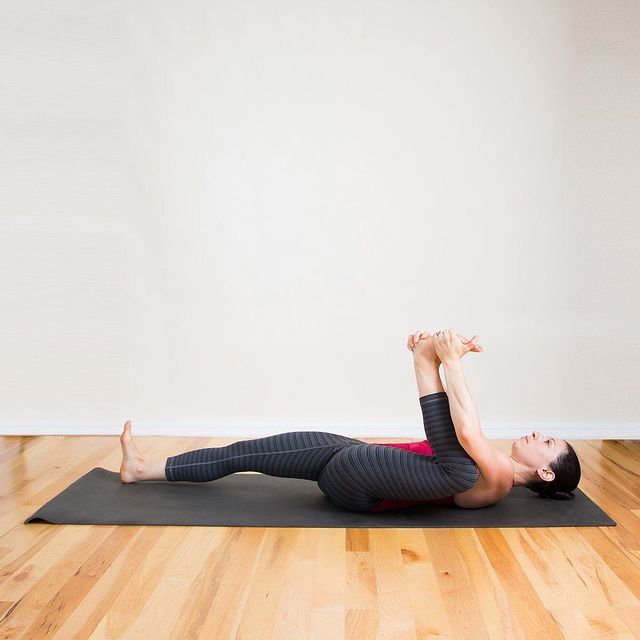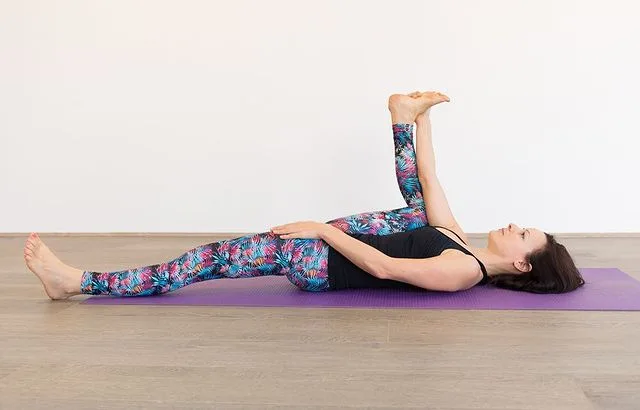Supta Padangusthasana Bent-Knee or Reclining Big-Toe Pose Bent-Knee, or Sleeping Big-Toe Pose Bent-Knee version focuses the stretch on the gluteus maximus and proximal hamstrings—the part of the muscle group that lies close to the origin of the sit bones.
Information
| Known as: | Supta Padangusthasana Bent-Knee, Reclining Big-Toe Pose Bent-Knee, Supta Padangusthasana Single Leg Reclining Lunge, Sleeping Big-Toe Pose Bent-Knee Version |
| Sanskrit name: | सुप्त पादाङ्गुष्ठासन |
| IAST: | Supta Pādāṅguṣṭhāsana |
| Pronunciation: | soup-TAH pod-ang-goosh-TAHS-anna |
| Level: | Intermediate |
| Type: | Reclining, relaxation, restorative, supine |
| Total time: | 30 seconds to 2 minutes |
| Drishti: | At ceiling; At big toe |
| Chakra: | Swadisthana Chakra, Muladhara Chakra |
| Focus: | Legs |
| Indications: | Prostate gland, menstrual, back discomfort, hip joints and prevents hernia, sciatica and paralysis |
| Counterpose: | Apanasana (Knees to Chest Pose) |
| Preparatory poses: | Uttanasana, Baddha Konasana, Adho Mukha Svanasana, Ardha Pavanamuktasana, Sleeping Big Toe Pose, Supta Padangusthasana B |
| Follow-up poses: | Standing Poses, Seated Forward Bends |
| Contraindications: | High blood pressure, Diarrhea, Headache |
Meaning
The Supta Padangusthasana is derived from the Sanskrit name, which is made up of four words — Supta + Pada + Angustha + Asana:
- “Supta” = “recline or lying down”
- “Pada” = “foot”
- “Angustha” = “big toe”
- “Asana” = “pose or posture”
Benefits of Supta Padangusthasana Bent-Knee (Sleeping Big-Toe Pose Bent-Knee)
Leg stretches a series of reclining exercises done one after the other will develop the legs properly. People suffering from sciatica and paralysis of legs will get a lot of benefit from Supta Padangusthasana. Blood is made to circulate to the legs and hips, where the veins are rejuvenated. This asana removes stiffness in the hip joints and prevents hernia. The pose can be practiced by both men and women.
Supta Padangusthasana Bent-Knee (Sleeping Big-Toe Pose Bent-Knee) Practice Guide
In this version of Supta Padangusthasana, we fully flex the hip of the leg while holding it in the hands. It focuses the stretch on the gluteus maximus and proximal hamstrings—the part of the muscle group that lies close to the origin of the sit bones.
Grab the leg and flex the elbows to draw the leg deeper to the side and increase the stretch in the buttocks; This is the main story of Supta Padangusthasana Bent-Knee (Sleeping Big-Toe Pose Bent-Knee). Contracting your abdominals flexes the trunk, creating a secondary action that deepens the main stretch. Engage the gluteals of the straight leg to extend the hip and quadriceps to straighten the knee. The action of the gluteus maximus will cause the foot to rotate outward. Resist this trend by turning the thigh inward. Where it is easier said than done, so in the muscle section, we provide a technique to accomplish this.
Step-by-step instructions to Supta Padangusthasana Bent-Knee

Instructions
- Lie flat on the floor; Engage your feet and spread your toes. Keep your upper thighs on the floor as much as possible. Bend your lower back slightly to help lower your thighs.
- Bend your left leg and grab the left leg again with both hands. Bring the knee towards your chest, and keeping the left heel directly over the left knee, make the shin-bone vertical. Then activate the right leg, slide the heel away from you, and press the sacrum flat. This will make the right side of your body heavy and stop bending.
- Pull down with your hands, try to touch the left knee with the floor. Keep your sacrum flat and right leg active; Do not tip sideways in your attempt to touch the floor. Lower your shoulders toward the floor, pulling in with your hands and rounding your chest. If this position is difficult for you, bend your right leg and slide the foot back until it is flat. Breathe comfortably, while exhaling, emphasize the action of stretching. Stay here a minute.
- Slide right foot backward, release left foot, and return to starting position: both feet bent, feet flat. Wait a few moments here. Absorb what just happened. Continue to breathe smoothly. Repeat the process with the right leg, then continue.
Beginner tip
- In the beginning, use a belt to tie the toe of the upper leg and keep the lower leg bent. Muscles have stretch receptors in the abdomen called muscle spindles that detect changes in length and tension.
- When a muscle is stretched, these receptors initiate a signal from the central nervous system that tells the muscle to contract to protect itself. Involvement of the muscles that form the general form of the pose optimizes the muscular axis. The contractile signal from the spine is then reduced, allowing relaxation of the posture.
- As you become more flexible, grasp the feet with your hands. Bend the elbows so that the force of contracting the biceps is directed downward through the long axis of the tibia.
- Now straighten the lower leg and stretch the hip to complete the asana.
Step-by-step Anatomy Engaging Techniques
Step-1
Use your psoas and its synergists, your pectineus and adductors longus and brevis, to initiate hip flexion. Note that once you are deep in the pose, these muscles have minimal effect on enhancing this action. Since muscles have maximum overlap of cross-bridges, they are unable to generate additional contractile force, if any. At this point, the hip is further flexed by the action of pulling the upper extremities down through the foot.
Step-2
Grab your foot with both hands and imagine lifting your arms up in front of you. Use this cue to activate your anterior deltoids, which flex your shoulders and thus draw your hips deeper into the pose. Then bend your elbows while contracting your biceps and brachialis muscles. Align your hands such that bending your elbows draws the direction of the force down through the long axis of the tibia.
Step-3
Grasp your feet by the hands and contract your rectus abdominis to flex trunk toward your thigh, pulling your foot deeply to the side. Fix your leg in this position with your arms extended and follow the instructions in Step-4.
Step-4
Extend your hip of the lower leg and arch your back. In Step-3, you bring the torso to your thigh by contracting your abdominals and keep your legs in this position by your arms. Here, you follow this action with engaging your erector spinae and quadratus lumborum. The back bend tilts your pelvis forward, deepening the stretch of your gluteals and hamstrings of your bent-leg.
Step-5
- Contract your straight-leg gluteus maximus to extend your hip. A side effect of engaging this muscle is that your thigh and leg will roll outward; You’ll address that in a moment.
- Activate your quadriceps to straighten your knee.
- Then press your heel into the floor and try to pull it to the side (abduction).
- Your heel rests on the mat, so it won’t really go sideways; However, the same muscles that abduct your leg (tensor fascia lata and gluteus medius) also rotate it inward.
- Thus, rubbing your heel to the side internally rotates your leg, bringing your kneecap to point straight up.
Precautions and contraindications
Here are some precautions and contraindications to keep in mind while practicing Supta Padangusthasana Bent-Knee (Sleeping Big-Toe Pose Bent-Knee):
- The hamstrings and quadriceps should primarily be avoided by athletes, as these muscles will deeply expand during the practice of this yoga pose.
- The strength of the legs and hips is tested in this yoga asana, and therefore if one has weak legs and hips, this yoga asana should be practiced under the guidance or support of an expert yoga teacher/instructor. It is also better to go slow with Supta Padangusthasana Bent-Knee (Sleeping Big-Toe Pose Bent-Knee).















